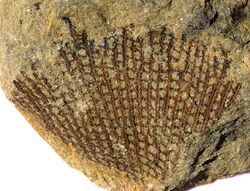Biology:Fenestella (bryozoan)
| Fenestella | |
|---|---|

| |
| Fenestella, 14 mm wide, Couvin | |
| Scientific classification | |
| Domain: | Eukaryota |
| Kingdom: | Animalia |
| Phylum: | Bryozoa |
| Class: | Stenolaemata |
| Order: | †Fenestrida |
| Family: | †Fenestellidae |
| Genus: | †Fenestella Lonsdale, 1839 M'Coy, 1844 non Fenestella Röding, 1798 |
| Type species | |
| Fenestella antiqua d'Orbigny, 1852
| |
| Synonyms | |
|
Fenestrella | |
Fenestella is a genus of bryozoans or moss animals, forming fan–shaped colonies with a netted appearance. It is known from the Middle Ordovician to the early Upper Triassic (Carnian), reaching its largest diversity during the Carboniferous. Many hundreds of species have been described from marine sediments all over the world.
Etymology
Fenestella is Latin, meaning little window, from fenestra "window", for the window-like openings in the mesh of the skeleton of its colonies.[1]
Description
The skeleton of Fenestella colonies consists of stiff branches that are interconnected by narrower crossbars (or dissepiments). Between two and eight individuals of the colony inhabit each of the opposing front sides of the approximately rectangular openings between the branches (or fenestule) in one row, and the void they left when they died can be recognized as two rows of small rimmed pores (or apertures) on the front of each branch. In well-preserved specimens these are closed by centrally perforated lids. In Fenestella, the front of the branches may carry small nodes in a row in the middle. Branches split (or bifurcate) from time to time giving the colonies a fan-shaped appearance.[2] The internal structure of the branches is of decisive importance in the assignment of specimens to genera and species, which greatly hampers identification of intact fossils. Compared to other fenestellids with two rows of apertures, Fenestella is relatively fine, with large apertures and wide dissepiments.[3] The distance between apertures in Fenestella remains the same as colonies grow and individuals (or zooids) will have had equal size lophophores.[4]
Taxonomy
In 1935 the name Fenestella M'Coy, 1844 was replaced by Fenestrellina, because it is a junior homonym of a bivalve, now considered synonymous with Anomia. In 1962 however, Fenestella was reinstated for the bryozoan genus. The misspelling Fenestrella became officially rejected.[5] The name in the early third millennium in general was given as Fenestella Lonsdale, 1839.[1][3][5]
Reassigned species
Because Fenestella was erected early on in paleontology, many species have since been reassigned to other Fenestellid genera.[2]
- F. ampla = Protoretepora ampla
- F. cinctuta = Anastomopora cinctuta
- F. conica = Ptiloporina conica
- F. conjunctiva = Isotrypa conjunctiva
- F. crassa = Fenestrellina crassa
- F. jabensis = Fenestepora jabensis
- F. lata = Unitrypa lata
- F. laticrescens = Ptiloporella laticrescens
- F. perforata = Loculipora perforata
- F. quincuncialis = Lyoporella quincuncialis
- F. subquadrans = Lyopora subquadrans
- F. wortheni = Archimedes wortheni
References
- ↑ 1.0 1.1 "fenestella". http://www.thefreedictionary.com/fenestella.
- ↑ 2.0 2.1 Moore, Raymond C. (1953). Volume G: Bryozoa. Treatise on Invertebrate Paleontology. Boulder, Colorado and Lawrence, Kansas: Geological Society of America and University of Kansas. pp. G120.
- ↑ 3.0 3.1 Hageman, Steven J.; McKinney, Frank K. (2013). "Discrimination of fenestrate bryozoan genera in morphospace". Palaeontologia Electronica 13 (2): 43 pages. http://palaeo-electronica.org/2010_2/206/.
- ↑ Starcher, Robert W.; McGhee Jr., George R. (2000). "Fenestrate Theoretical Morphology: Geometric Constraints on Lophophore Shape and Arrangement in Extinct Bryozoa". Paleobiology 26 (1): 116–136. doi:10.1666/0094-8373(2000)026<0116:ftmgco>2.0.co;2.
- ↑ 5.0 5.1 Brock, Phil (2010-04-22). "Fenestella". http://bryozoa.net.
Wikidata ☰ Q20975616 entry
 |

